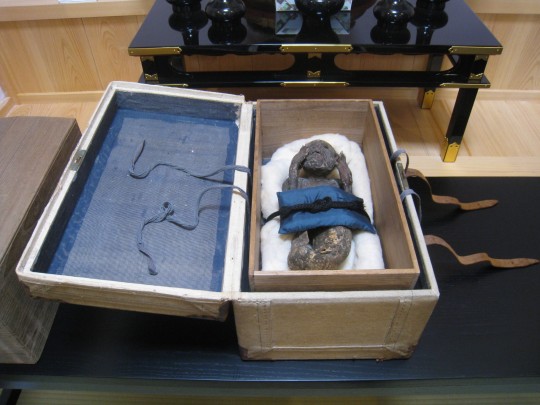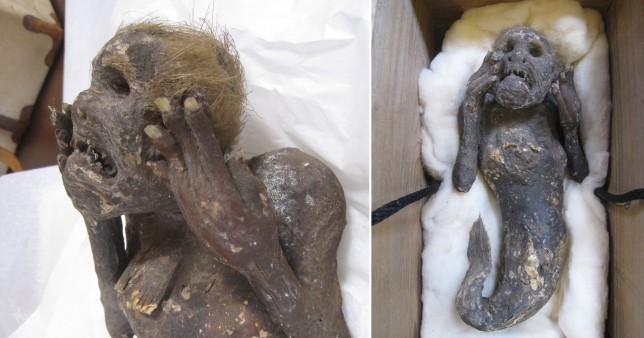An ancient mummified ‘mermaid’ that supposedly grants immortality to anyone that tastes its flesh is to be examined by scientists. The creature, with a human-looking face and a tail, has baffled experts for centuries. It was allegedly caught in the Pacific Ocean, off the Japanese island of Shikoku, between 1736 and 1741. Now it rests in a temple in the city of Asakuchi.
The creature has its two hands reaching up towards its grimacing face. Hair is still visible on its head and it has the remains of sharp, pointy teeth in its mouth. Researchers from the Kurashiki University of Science and the Arts have taken the mummy for CT scanning in a bid to unravel its mysteries. Hiroshi Kinoshita of the Okayama Folklore Society, who came up with the project, said the mummy could have religious significance.
‘Japanese mermaids have a legend of immortality,’ he said. ‘It is said that if you eat the flesh of a mermaid, you will never die. There is a legend in many parts of Japan that a woman accidentally ate the flesh of a mermaid and lived for 800 years. ‘This ‘Yao-Bikuni’ legend is also preserved near the temple where the mermaid mummy was found. ‘I heard that some people, believing in the legend, used to eat the scales of mermaid mummies.’

In the age of Covid-19, a mermaid could be an ominous portent too, folklore suggests. ‘There is also a legend that a mermaid predicted an infectious disease,’ said Hiroshi.
A historic letter dated to 1903 – apparently penned by a former owner – was stored alongside the mummy and gives a story about its provenance. ‘A mermaid was caught in a fish-catching net in the sea off Kochi Prefecture,’ the letter states. ‘The fishermen who caught it did not know it was a mermaid, but took it to Osaka and sold it as unusual fish.
‘My ancestors bought it and kept it as a family treasure.’ It’s unclear how or when the mummy came to Enjuin temple in Asakuchi. But chief priest, Kozen Kuida, said it was put on display in a glass case some 40 years ago and is now kept in a fireproof safe.
Kinoshita, however, takes a more pragmatic view of the creature. He believes it was manufactured at some point during the Edo period – an era of Japanese history stretching from 1603 to 1867. ‘Of course, I don’t think it’s a real mermaid,’ he said. ‘I think this was made for export to Europe during the Edo period, or for spectacles in Japan. ‘The legend of mermaids remains in Europe, China and Japan all over the world. ‘Therefore, I can imagine that people at that time were also very interested in it.’ He continued: ‘I think it is made from living animals and we would like to identify them by CT scans or DNA testing. ‘It looks like a fish with scales on the lower body and a primate with hands and a face on the upper body.’
The scientists examining the mummy will publish their findings later this year.

